病理生理学英文名词解释精选
病理生理学名词中英文对照
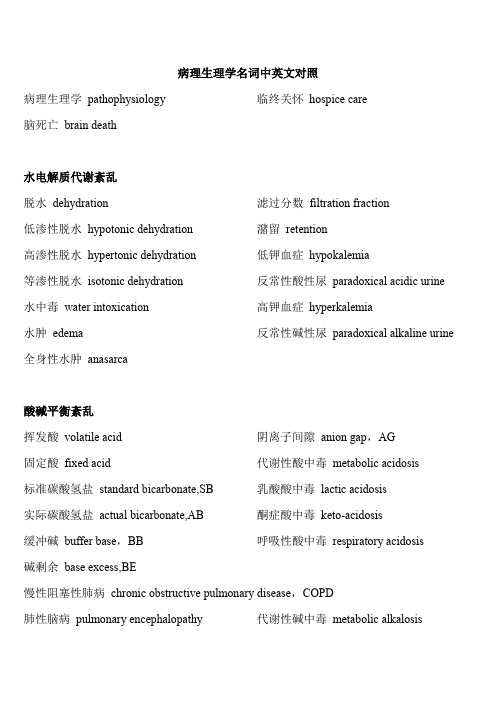
病理生理学名词中英文对照病理生理学pathophysiology脑死亡brain death临终关怀hospice care 水电解质代谢紊乱脱水dehydration低渗性脱水hypotonic dehydration 高渗性脱水hypertonic dehydration 等渗性脱水isotonic dehydration 水中毒water intoxication水肿edema全身性水肿anasarca 滤过分数filtration fraction潴留retention低钾血症hypokalemia反常性酸性尿paradoxical acidic urine 高钾血症hyperkalemia反常性碱性尿paradoxical alkaline urine酸碱平衡紊乱挥发酸volatile acid固定酸fixed acid标准碳酸氢盐standard bicarbonate,SB 实际碳酸氢盐actual bicarbonate,AB 缓冲碱buffer base,BB碱剩余base excess,BE 阴离子间隙anion gap,AG代谢性酸中毒metabolic acidosis 乳酸酸中毒lactic acidosis酮症酸中毒keto-acidosis呼吸性酸中毒respiratory acidosis慢性阻塞性肺病chronic obstructive pulmonary disease,COPD肺性脑病pulmonary encephalopathy 代谢性碱中毒metabolic alkalosis盐水反应性碱中毒saline-responsive alkalosis盐水抵抗性碱中毒saline-resistant alkalosis呼吸性碱中毒respiratory alkalosis双重性酸碱失衡double acid-base disorders 缺氧缺氧hypoxia血氧分压partial pressure of oxygen,PO2 血氧容量oxygen binding capacity,CO2max 血氧含量oxygen content,CO2低张性缺氧hypotonic hypoxia乏养性缺氧hypoxic hypoxia发绀cyanosis血液型缺氧hemic hypoxia等张性缺氧isotonic hypoxia 碳氧血红蛋白carboxyhemoglobin,HbCO 高铁血红蛋白methemoglobin,HbFe3+OH 肠源性发绀enterogenous cyanosis循环性缺氧circulatory hypoxia低动力性缺氧hypokinetic hypoxia缺血性缺氧ischemic hypoxia组织性缺氧histogenous hypoxia氧利用障碍性缺氧dysoxidative hypoxia 高原肺水肿high altitude pulmonary edema周期性呼吸periodic breat发热发热fever 过热hyperthermia 视前区下丘脑前部preoptic anterior hypothalamus,POAH内毒素endotoxin,ET致热原pyrogen中杏仁核medial amygdaloid nucleus稽留期fastigium腹中隔ventral septal area,VSA前列腺素prostaglandin,PG热限febrile ceiling应激应激stress良性应激eustress 劣性应激distress 交感-肾上腺髓质系统sympathetic-adrenal medulla system去甲肾上腺素norepinephrine,NE应激性溃疡stress ulcer肠易激综合征irritable bowel syndrome,糖皮质激素glucocorticoid,GC蓝斑locus ceruleus 边缘系统limbic system室旁核paraventricular nucleus抗利尿激素antidiuretic hormone,ADH 急性期反应蛋白acute phase protein,AP下丘脑-垂体-肾上腺皮质系统hypothalamus-pituitary-adrenal cortex system,HPA缺血-再灌注损伤缺血-再灌注损伤ischemia-reperfusion injury,IRI缺血后适应postconditioning氧自由基oxygen free radical黄嘌呤氧化酶xanthine oxidase,XO黄嘌呤脱氢酶xanthine dehydrogenase,XD 呼吸爆发respiratory burst氧爆发oxygen burst 脂质过氧化lipid peroxidation钙超载calcium overload心肌顿抑myocardial stunning再灌注心律失常reperfusion arrhythmia 胀亡oncosis休克休克shock虚脱collapse脓毒性休克septic shock 过敏性休克anaphylactic shock脓毒症sepsis低血容量性休克hypovolemic shock 血管源性休克vasogenic shock微循环microcirculation一氧化氮nitric oxide,NO休克代偿期ischemic anoxia phase 休克失代偿期decompensatory stage 淤血性缺氧期stagnant anoxia phase 白细胞滚动rolling微循环衰竭期microcirculatory failure phase无复流现象no-reflow phenomenon全身炎症反应综合征systemic inflammatory response syndrome,SIRS 急性呼吸窘迫综合征acute respiratorydistress syndrome,ARDS休克肺shock lung多器官功能障碍综合征mutilple organ dysfunction syndrome,MODS 抗凝血平衡紊乱纤溶酶原激活物plasminogen activator,PA弥漫性血管内凝血disseminated intravascular coagulation,DIC裂体细胞schistocyte微血管病性溶血性贫血microangiopathic hemolytic anemia心功能不全心功能不全cardiac insufficiency心力衰竭heart failure前负荷preload容量负荷volume load后负荷afterload压力负荷pressure load低输出量性心力衰竭low output heart failure高输出量性心力衰竭high output heart failure心室重塑ventricular remodeling离心性肥大eccentric hypertrophy颈静脉充盈engorgement of neck vein 肺水肿pulmonary edema 呼吸困难dyspnea劳力性呼吸困难dyspnea on exertion 向心性肥大concentric hypertrophy 心性哮喘cardiac asthma夜间阵发性呼吸困难paroxysmal nocturnal dyspnea端坐呼吸orthopnea肺功能不全呼吸衰竭respiratory failure低氧血症型呼吸衰竭hypoxemic respiratory failure伴有高碳酸血症性低氧血症呼吸衰竭hypercapnic respiratory failure限制性通气不足restrictive hypoventilation 阻塞性通气不足obstructive hypoventilation 吸气性呼吸困难inspiratory dyspnea 呼气性呼吸困难expiratory dyspnea弥散障碍diffusion impairment通气与血流比例失调ventilation-perfusion imbalance功能性分流functional shunt静脉血掺杂venous admixture死腔样通气dead space like ventilation 解剖分流anatomic shunt 真性分流true shunt急性呼吸窘迫综合症acute respiratory distress syndrome,ARDS 慢性阻塞性肺病chronic obstructive pulmonary disease,COPD CO2麻醉carbon dioxide narcosis肺性脑病pulmonary encephalopathy肝功能不全肝功能不全hepatic insufficiency肝功能衰竭hepatic failure肝性脑病hepatic encephalopathy,HE 肝昏迷hepatic coma 扑翼样震颤asterixis氨中毒学说ammonia intoxication hypothesis假性神经递质学说false neurotransmitter hypothesis苯乙醇胺phenylethanolamine 羟苯乙醇胺octpamine 氨基酸失衡学说amino acid imbalance hypothesis芳香族氨基酸aromatic amino acid,AAA 支链氨基酸branched chain amino,BCAA GABA 学说GABA hypothesis肝肾综合症hepatorenal syndrome,HRS肾功能不全肾功能不全renal insufficiency 肾功能衰竭renal failure急性肾功能衰竭acute renal failure,ARF 慢性肾功能不全chronic renal failure,CRF 尿毒症uremia肾前性急性肾功能衰竭prerenal failure 功能性肾功能衰竭functional renal failure 肾前性氮质血症prerenal azotemia肾性急性肾功能衰竭intrarenal failure器质性肾功能衰竭parenchymal renal failure肾小管细胞和间质细胞损伤学说tubular and interstitial cells lesion hypothesis 急性肾小管坏死acute tubular necrosis,ATN肾后性急性肾功能衰竭postrenal failure 肾后性氮质血症postrenal azotemia少尿oliguria无尿anuria 多尿polyuria氮质血症azotemia健存肾单位假说intant nephron hypothesis 矫枉失衡学说trade-off hypothesis肾小球过度滤过假说glomerular hyperfiltration hypothesis夜尿nocturia等渗尿isothenuria低渗尿hyposthenuria血浆氮质尿blood urea nitrogen,BUN 高磷血症hyperphosphatemia高钾血症hyperkalemia肾性骨营养不良renal osteodystrophy 肾性高血压renal hypertension钠依赖性高血压sodium-dependent hypertension 肾素依赖性高血压renin-dependent hypertension 肾性贫血renal anemia终末期肾功能衰竭end-stage renal failure,ESRF 尿毒症性脑病uremic encephalopathy尿素霜urea cream。
病理生理学英文名词解释精选

1.DiseaseDisease is referred as an aberrant manifestation of homeostatic disturbances caused by harmful agents.2.Causative factor / pathogenic causeCausative factor or pathogenic cause is referred as the factor that can cause a disease and determine its specificity.3.HypoxiaHypoxia can be defined as a deficiency in either oxygen delivery or its utilization at the tissue level or the deficiency of both, which can lead to changes in function, metabolism and even structure of the body.4.CyanosisCyanosis refers to the violaceous color of skin and mucous membranes which occurs as the deoxyhemoglobin concentration of the blood in capillaries becomes greater than 5g/dl.5.Hemic hypoxiaHemic hypoxia refers to hypoxia resulting from a low carrying capacity of oxygen in the blood caused by an altered affinity of Hb for oxygen or a decrease in the amount of Hb in the blood.nterogenous cyanosisWhen pickled vegetables containing nitrate are consumed in large amounts, the reabsorbed nitrate reacts with HbFe2+to form HbFe3+OH. The color of skin becomes coffee color. This phenomenon is called enterogenous cyanosis.schemic hypoxiaThe deficiency of blood perfusion to tissues caused by decreased arterial pressure or obstruction of arteries is called ischemic hypoxia.8.FeverFever is a complicated pathological process characterized by a regulated elevation of core body temperature, in which the hypothalamic set point is temporarily reset at an elevated temperature in response to pyretic substances.yrogenic activatorsFever can be caused by a number of microorganisms and non-microbial pyretic substances, which are collectively called pyrogenic activators.10.Endogenous pyrogensEndogenous pyrogens are described as cytokines inducing fever, which are produced and released by EP cells, such as interleukin-1, tumor necrosis factor, etc.It is defined as a systemic nonspecific response of the body to environmental demands or pressures made upon it.12.StressorThe stimulus that provokes a stress response is referred to as stressor.13.ShockShock is a pathological process caused by various drastic etiological factors, which is characterized by microcirculation failure resulting from decreased effective circulatory blood volume and inadequate tissue perfusion with the results of cellular metabolism impediment and dysfunction of multiple vital organ.uto blood transfusionAt the early stage of shock, vessel constriction because of release of a large amount of vasoconstrictors may mobilize the stored blood to participate in the circulation, which is considered as compensation of venous return.uto fluid transfusionAt the early stage of shock, significant decrease of hydrostatic pressure in capillary may drive fluid to shift from interstitial space to the vascular compartment, and as a result, the plasma volume can be partly restored as a compensatory response isseminated intravascular coagulation (DIC)DIC is a pathological process caused by disturbance of the kinetic balance between coagulation and anticoagulation systems (including fibrinolytic system). Etiologic factors activate extensive intravascular coagulation and secondary fibrinolysis. Theclinical features of DIC are bleeding, shock, organ dysfunction and microangiopathic hemolytic anemia.17.Heart failureHeart failure is a pathological process in which the systolic or/ and diastolic function of the heart is impaired, and as a result, cardiac output decreases and is unable to meet the metabolic demands of the body.18.High-output failureHigh-output failure indicates that the cardiac output may be supra- normal but inadequate owing to excessive metabolic needs. The causes of high-output heart failure include severe anemia, fever, hyperthyroidism and pregnancy, etc.schemia- reperfusion injuryThe restoration of blood flow after transient ischemia may be associated with further reversible or irreversible cell damage, which is called ischemia-reperfusion injury or reperfusion injury.20.Calcium overloadCalcium overload refers to that intracellular content of calcium is increased abnormally during ischemia and reperfusion, which results in the disorder of cellular structure and function.21.Systemic inflammatory response syndrome (SIRS)Systemic inflammatory response syndrome is a hard-controlling systemic inflammatory cascade caused by severe infectious or non-infectious factors. It leads to disorders of microcirculatory perfusion of organs and finally to secondary organ dysfunction.22.Multiple organ dysfunction syndrome (MODS)Multiple organ dysfunction syndrome is defined as a progressive dysfunction of two or more organs or systems resulting from an uncontrolled systemic inflammatory response to a severe illness or injury.nion gap (AG)It is the deference between the concentrations of unmeasured anion (UA) and unmeasured cation (UC) in plasma (AG=UA-UC). The AG value can be obtained by calculating the difference between plasma concentration of major measuredcation (Na +) and the sum of the plasma concentrations of major measured anions (Cl - and HCO 3-), that is, AG = [Na +] - ([Cl -]+ [HCO 3-]). Its normal range is 12±2 mmol/L.24.EdemaEdema means that excessive fluid accumulates in interstitial compartment and some cavities in the body.25.Brain deathBrain death is a state of permanent irreversible cessation of whole brain activity. At that time, the function of the patient's body as a whole body has stopped forever.。
《病理生理学》名词解释
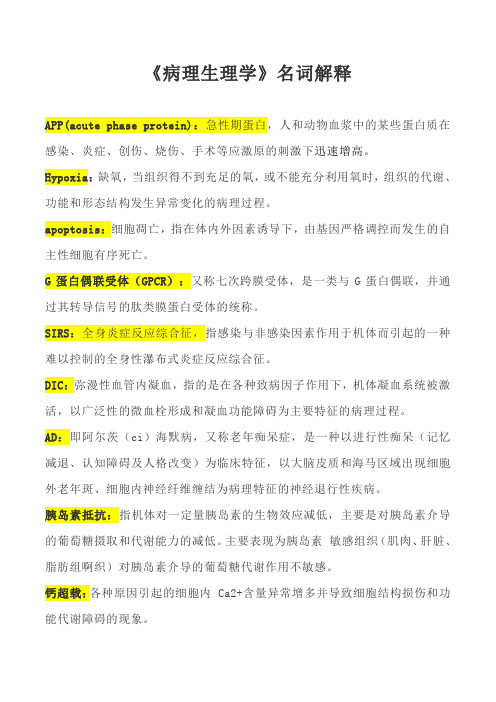
《病理生理学》名词解释APP(acute phase protein):急性期蛋白,人和动物血浆中的某些蛋白质在感染、炎症、创伤、烧伤、手术等应激原的刺激下迅速增高。
Hypoxia:缺氧,当组织得不到充足的氧,或不能充分利用氧时,组织的代谢、功能和形态结构发生异常变化的病理过程。
apoptosis:细胞凋亡,指在体内外因素诱导下,由基因严格调控而发生的自主性细胞有序死亡。
G蛋白偶联受体(GPCR):又称七次跨膜受体,是一类与G蛋白偶联,并通过其转导信号的肽类膜蛋白受体的统称。
SIRS:全身炎症反应综合征,指感染与非感染因素作用于机体而引起的一种难以控制的全身性瀑布式炎症反应综合征。
DIC:弥漫性血管内凝血,指的是在各种致病因子作用下,机体凝血系统被激活,以广泛性的微血栓形成和凝血功能障碍为主要特征的病理过程。
AD:即阿尔茨(ci)海默病,又称老年痴呆症,是一种以进行性痴呆(记忆减退、认知障碍及人格改变)为临床特征,以大脑皮质和海马区域出现细胞外老年斑、细胞内神经纤维缠结为病理特征的神经退行性疾病。
胰岛素抵抗:指机体对一定量胰岛素的生物效应减低,主要是对胰岛素介导的葡萄糖摄取和代谢能力的减低。
主要表现为胰岛素敏感组织(肌肉、肝脏、脂肪组啊织)对胰岛素介导的葡萄糖代谢作用不敏感。
钙超载:各种原因引起的细胞内 Ca2+含量异常增多并导致细胞结构损伤和功能代谢障碍的现象。
心脏前负荷:又称为容量负荷,是指心脏收缩之前遇到的负荷,实际上是心室舒张容量或心室舒张末期室壁张力的压力。
慢性呼吸衰竭:由于一些慢性的肺部疾患, COPD等而引起的氧分压下降伴有或不伴有二氧化碳分压上升,并伴有一系列生理功能和代谢紊乱的综合症。
血管源性休克:由于外周血管扩张,血管容量扩带来血液分布异常,大量血淤滞在小血管内,使有效循环血量下降引起的休克氧含量:是指100 ml血液中实际含有的氧量,主要取决于血氧分压和血氧容量。
细胞信号传导:通过受体感受信息分子的刺激,再经复杂的信号转导系统的转换,从而影响细胞生物学功能的过程称为细胞信号转导。
病理生理学名词解释
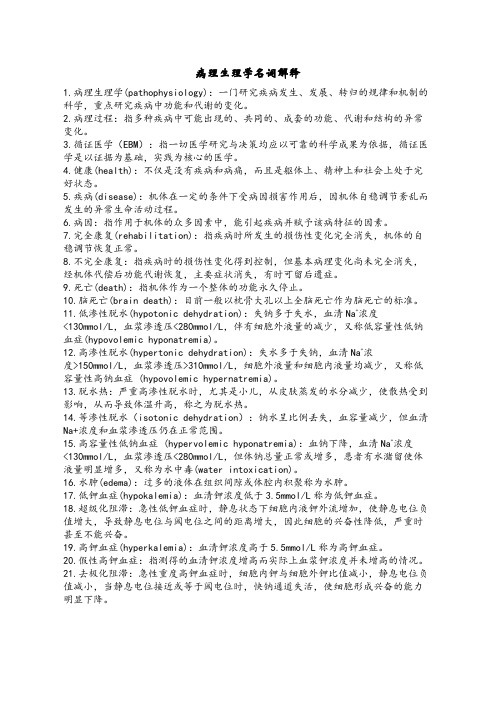
病理生理学名词解释1.病理生理学(pathophysiology):一门研究疾病发生、发展、转归的规律和机制的科学,重点研究疾病中功能和代谢的变化。
2.病理过程:指多种疾病中可能出现的、共同的、成套的功能、代谢和结构的异常变化。
3.循证医学(EBM):指一切医学研究与决策均应以可靠的科学成果为依据,循证医学是以证据为基础,实践为核心的医学。
4.健康(health):不仅是没有疾病和病痛,而且是躯体上、精神上和社会上处于完好状态。
5.疾病(disease):机体在一定的条件下受病因损害作用后,因机体自稳调节紊乱而发生的异常生命活动过程。
6.病因:指作用于机体的众多因素中,能引起疾病并赋予该病特征的因素。
7.完全康复(rehabilitation):指疾病时所发生的损伤性变化完全消失,机体的自稳调节恢复正常。
8.不完全康复:指疾病时的损伤性变化得到控制,但基本病理变化尚未完全消失,经机体代偿后功能代谢恢复,主要症状消失,有时可留后遗症。
9.死亡(death):指机体作为一个整体的功能永久停止。
10.脑死亡(brain death):目前一般以枕骨大孔以上全脑死亡作为脑死亡的标准。
11.低渗性脱水(hypotonic dehydration):失钠多于失水,血清Na+浓度<130mmol/L,血浆渗透压<280mmol/L,伴有细胞外液量的减少,又称低容量性低钠血症(hypovolemic hyponatremia)。
12.高渗性脱水(hypertonic dehydration):失水多于失钠,血清Na+浓度>150mmol/L,血浆渗透压>310mmol/L,细胞外液量和细胞内液量均减少,又称低容量性高钠血症 (hypovolemic hypernatremia)。
13.脱水热:严重高渗性脱水时,尤其是小儿,从皮肤蒸发的水分减少,使散热受到影响,从而导致体温升高,称之为脱水热。
病理生理学名词解释
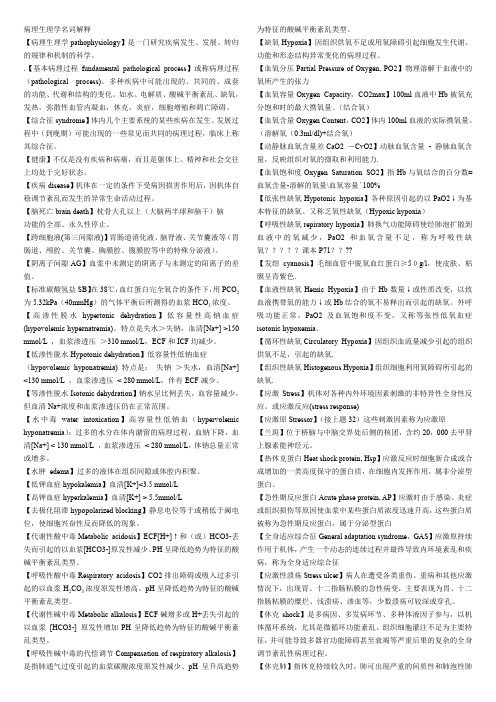
病理生理学名词解释【病理生理学pathophysiology】是一门研究疾病发生、发展、转归的规律和机制的科学。
.【基本病理过程fundamental pathological process】或称病理过程(pathological process)。
多种疾病中可能出现的、共同的、成套的功能、代谢和结构的变化。
如水、电解质、酸碱平衡紊乱、缺氧,发热,弥散性血管内凝血,休克,炎症,细胞增殖和凋亡障碍。
【综合征syndrome】体内几个主要系统的某些疾病在发生、发展过程中(到晚期)可能出现的一些常见而共同的病理过程,临床上称其综合征。
【健康】不仅是没有疾病和病痛,而且是躯体上、精神和社会交往上均处于完好状态。
【疾病disease】机体在一定的条件下受病因损害作用后,因机体自稳调节紊乱而发生的异常生命活动过程。
【脑死亡brain death】枕骨大孔以上(大脑两半球和脑干)脑功能的全部、永久性停止。
【跨细胞液(第三间隙液)】胃肠道消化液、脑脊液、关节囊液等(胃肠道、颅腔、关节囊、胸膜腔、腹膜腔等中的特殊分泌液)。
【阴离子间隙AG】血浆中未测定的阴离子与未测定的阳离子的差值。
【标准碳酸氢盐SB】在38℃,血红蛋白完全氧合的条件下,用PCO2为5.32kPa(40mmHg)的气体平衡后所测得的血浆HCO3浓度。
【高渗性脱水hypertonic dehydration】低容量性高钠血症(hypovolemic hypernatremia)。
特点是失水>失钠,血清[Na+] >150 mmol/L ,血浆渗透压>310 mmol/L,ECF和ICF均减少。
【低渗性脱水Hypotonic dehydration】低容量性低钠血症(hypovolemic hyponatremia) 特点是:失钠>失水,血清[Na+] <130 mmol/L ,血浆渗透压< 280 mmol/L,伴有ECF减少。
病理生理学名词解释
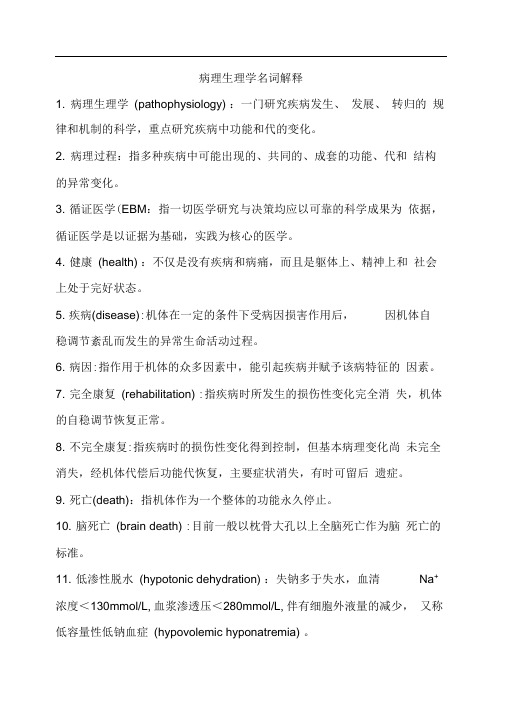
病理生理学名词解释1. 病理生理学(pathophysiology) :一门研究疾病发生、发展、转归的规律和机制的科学,重点研究疾病中功能和代的变化。
2. 病理过程:指多种疾病中可能出现的、共同的、成套的功能、代和结构的异常变化。
3. 循证医学(EBM:指一切医学研究与决策均应以可靠的科学成果为依据,循证医学是以证据为基础,实践为核心的医学。
4. 健康(health) :不仅是没有疾病和病痛,而且是躯体上、精神上和社会上处于完好状态。
5. 疾病(disease):机体在一定的条件下受病因损害作用后,因机体自稳调节紊乱而发生的异常生命活动过程。
6. 病因:指作用于机体的众多因素中,能引起疾病并赋予该病特征的因素。
7. 完全康复(rehabilitation) :指疾病时所发生的损伤性变化完全消失,机体的自稳调节恢复正常。
8. 不完全康复:指疾病时的损伤性变化得到控制,但基本病理变化尚未完全消失,经机体代偿后功能代恢复,主要症状消失,有时可留后遗症。
9. 死亡(death):指机体作为一个整体的功能永久停止。
10. 脑死亡(brain death) :目前一般以枕骨大孔以上全脑死亡作为脑死亡的标准。
11. 低渗性脱水(hypotonic dehydration) :失钠多于失水,血清Na+浓度<130mmol/L,血浆渗透压<280mmol/L,伴有细胞外液量的减少,又称低容量性低钠血症(hypovolemic hyponatremia) 。
12. 高渗性脱水(hypertonic dehydration) :失水多于失钠,血清Na+ 浓度>150mmol/L,血浆渗透压>310mmol/L,细胞外液量和细胞液量均减少,又称低容量性高钠血症(hypovolemic hypernatremia) 。
13. 脱水热:严重高渗性脱水时,尤其是小儿,从皮肤蒸发的水分减少,使散热受到影响,从而导致体温升高,称之为脱水热。
病理生理学名词解释
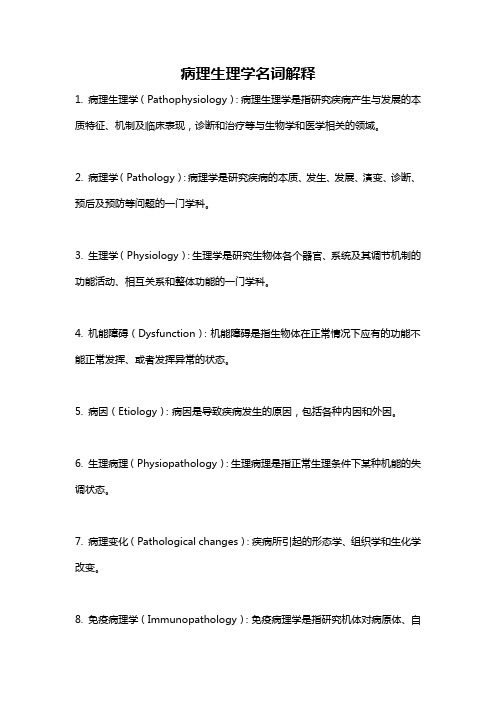
病理生理学名词解释1. 病理生理学(Pathophysiology):病理生理学是指研究疾病产生与发展的本质特征、机制及临床表现,诊断和治疗等与生物学和医学相关的领域。
2. 病理学(Pathology):病理学是研究疾病的本质、发生、发展、演变、诊断、预后及预防等问题的一门学科。
3. 生理学(Physiology):生理学是研究生物体各个器官、系统及其调节机制的功能活动、相互关系和整体功能的一门学科。
4. 机能障碍(Dysfunction):机能障碍是指生物体在正常情况下应有的功能不能正常发挥、或者发挥异常的状态。
5. 病因(Etiology):病因是导致疾病发生的原因,包括各种内因和外因。
6. 生理病理(Physiopathology):生理病理是指正常生理条件下某种机能的失调状态。
7. 病理变化(Pathological changes):疾病所引起的形态学、组织学和生化学改变。
8. 免疫病理学(Immunopathology):免疫病理学是指研究机体对病原体、自身组织或异位物质等的免疫反应引起的疾病的产生和发展过程的学科。
9. 缺血再灌注损伤(Ischemia-reperfusion injury):缺血再灌注损伤是指因缺血引起的组织或器官损伤,在再灌注后加重或恶化的伤害过程。
10. 氧化应激(Oxidative stress):氧化应激是指氧化代谢和抗氧化系统失衡,导致自由基、氧化物和抗氧化剂之间的失衡状态。
11. 炎症(Inflammation):炎症是指机体对外界刺激作出的一种非特异性的生物反应,包括血管扩张、渗出、炎症细胞浸润、组织修复等过程。
12. 组织修复(Tissue repair):组织修复是指在组织损伤后,机体通过不同机制的反应来恢复损伤的组织结构和功能。
13. 管腔阻塞(Luminal obstruction):管腔阻塞是指管腔内存在一种物质,阻碍了管腔的正常通畅,导致组织器官营养不良或坏死等病理生理现象的发生。
病理生理学_名词解释_考试要点
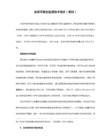
5.诱因(precipitating factor):能加强病因作用或促进疾病发生的因素。
6.脑死亡(brain death):枕骨大孔以上全脑功能停止,意味着机体作为一个整体的功能永久停止,这是判断脑死亡的标志。
37.急性肾功能衰竭:各种原因在短时间内引起肾脏泌尿功能急剧降低,以致代谢产物在体内潴留,
水、电解质和酸碱平衡失调,机体内环境发生严重紊乱,其主要代谢变化氮质血症、高钾血症、代谢性酸中毒和水中毒等综合征,称为急性肾功能衰竭。
38. 低渗尿,肾功能障碍时,由于浓缩功能减退而稀释功能正常,尿渗压最高只能在到700 mmol/L,尿
17.(碱)中毒。是指由于各种原因导致血浆中[HC03](或[H2C03 J)原发
性减少(或增多),引起代谢性(呼吸性)酸(碱)中毒,通过机体代偿调节,仍能使血浆中【NaHC03}/
【H2Co3]比值维持20:1,血pH值维持在正常范围,称为代偿性代谢性酸中毒。
18. 缺氧(hypoxia):指由于氧的供给不足或和利用障碍,组织的代谢、功能甚至形态结构发生异常变化的病理过程
9.低容量性高钠血症(高渗性脱水):其特点是失水>na+,血清na浓度>150mmol/L,细胞外液流量和细胞内液量均减少,以细胞内液减少明显。又称高渗性脱水。
10。水肿(edema):指过多的液体在组织间隙或体腔内积聚的病理过程。
11.显性水肿(frank edema):当皮下组织有过多的液体积聚时,皮肤肿胀,弹性差,皱纹变浅,用手按压后留下的凹陷,需经数秒到1分钟左右才平复,称为凹陷性水肿( pitting edema),亦称为显性水肿。
病理生理学名词解释
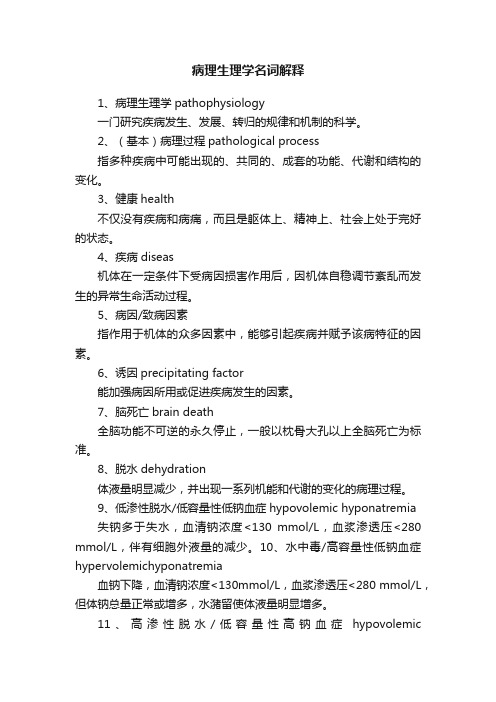
病理生理学名词解释1、病理生理学pathophysiology一门研究疾病发生、发展、转归的规律和机制的科学。
2、(基本)病理过程pathological process指多种疾病中可能出现的、共同的、成套的功能、代谢和结构的变化。
3、健康health不仅没有疾病和病痛,而且是躯体上、精神上、社会上处于完好的状态。
4、疾病diseas机体在一定条件下受病因损害作用后,因机体自稳调节紊乱而发生的异常生命活动过程。
5、病因/致病因素指作用于机体的众多因素中,能够引起疾病并赋予该病特征的因素。
6、诱因precipitating factor能加强病因所用或促进疾病发生的因素。
7、脑死亡brain death全脑功能不可逆的永久停止,一般以枕骨大孔以上全脑死亡为标准。
8、脱水dehydration体液量明显减少,并出现一系列机能和代谢的变化的病理过程。
9、低渗性脱水/低容量性低钠血症hypovolemic hyponatremia失钠多于失水,血清钠浓度<130 mmol/L,血浆渗透压<280 mmol/L,伴有细胞外液量的减少。
10、水中毒/高容量性低钠血症hypervolemichyponatremia血钠下降,血清钠浓度<130mmol/L,血浆渗透压<280 mmol/L,但体钠总量正常或增多,水潴留使体液量明显增多。
11、高渗性脱水/低容量性高钠血症hypovolemichypernatremia失水多于失钠,血清钠浓度>150 mmol/L,血浆渗透压>310mmol/L,细胞内、外液量均减少。
12、等渗性脱水isotomic dehydration钠水呈比例丢失,血容量减少,但血清钠浓度与血浆渗透压仍在正常范围之内。
13、脱水热皮肤蒸发水分减少,散热障碍所致体温升高的现象。
14、水肿edema过多的体液在组织间隙或体腔内积聚,发生在体腔内称为积水。
15、低钾血症hypokalemia血清钾浓度<3.5mmol/L。
病理生理学 老师名词解释

绪论疾病(disease):指机体在一定病因和条件作用下,超过自身调节的限度而发生的一系列异常生命活动过程。
健康(health):不仅是没有疾病和病痛,还要有健全的身心状态及社会适应能力。
应激应激(stress):是指机体在受到强烈的内外因素刺激时所出现的非特异性全身反应,其刺激因素称为应激原。
全身适应综合征GAS:劣性应激原持续作用于机体,应激可表现为一个动态的连续过程(分三期),并最终导致内环境紊乱和疾病,甚至死亡。
HSP:热休克蛋白,指在热应激(或其他应激)时细胞新合成或合成增加的一组蛋白质,又名应激蛋白,主要在细胞内发挥功能,属非分泌型蛋白质。
急性期反应蛋白(APP):应激由于感染、炎症或组织损伤等原因可使血浆中某些蛋白质浓度迅速变化,这种反应称为急性期反应(APR),这些蛋白质被称为急性期反应蛋白,属分泌型蛋白。
主要由肝细胞合成,单核巨噬细胞,成纤维细胞可产生少数急性期反应蛋白。
应激性溃疡(SU):病人在遭受各种重伤、重病等应激后,出现胃、十二指肠粘膜急性病变,主要表现为胃、十二指肠粘膜糜烂、渗血、溃疡等,少数病人可出现出血、穿孔。
PTSD:创伤后应激障碍,指创伤事件的精神后果,也即对异乎寻常的威胁性、灾难性等事件的严重情绪应激的一种延迟或持久的精神障碍表现。
分急性、慢性、延迟发作性PTSD水电解质代谢紊乱低渗性脱水(hypotonic dehydration)(低容量性低钠血症):失钠多于失水,血清钠浓度低于130mmol/L,血浆渗透压低于280mmol/L,伴有细胞外液量减少。
高渗性脱水(hypertonic dehydration)(低容量性高钠血症):失水多于失钠,血清钠浓度高于150mmol/L,血浆渗透压高于310mmol/L,细胞内液和细胞外液都减少。
等渗性脱水(isotonic dehydration)(血钠正常,细胞外液容量减少):水钠等比例丢失,血清钠浓度为130~150mmol/L,血浆渗透压为280~310mmol/L,水中毒(water intoxication)(高容量性低钠血症):血清钠浓度低于130mmol/L,血浆渗透压低于280mmol/L, 但体钠总量正常或增多,患者有水潴留使体液量明显增多。
病理生理学名词解释+问答题(带英文)

病理生理学考博资料名词解释:病理生理学(Pathologic Physiology或Pathophysiology),是基础医学理论学科之一,它同时还肩负着基础医学课程到临床课程之间的桥梁作用。
它的任务是研究疾病发生的原因和条件,研究整个疾病过程中的患病机体的机能、代谢的动态变化及其发生机理,从而揭示疾病发生、发展和转归的规律,阐明疾病的本质,为疾病的防治提供理论基础。
1、水肿(edema):体液在组织间隙或体腔积聚过多,称为水肿2、代谢性碱中毒(metabolic alkalosis):由于血浆中NaHCO3原发性增加,继而引起H2CO3含量改变,使NaHCO3/H2CO3>20/1,血浆pH升高的病理改变。
3、代谢性酸中毒(metabolic acidosis):由于血浆中NaHCO3原发性减少,继而引起H2CO3含量改变,使NaHCO3/ H2CO3<20/1,血浆PH值下降的病理过程。
4、呼吸性碱中毒(respiratory alkalosis):由于血浆中H2CO3原发性减少,使血浆NaHCO3/H2CO3增加,血浆pH 值升高的病理过程。
5、呼吸性酸中毒(respiratory acidosis):由于血浆中H2CO3原发性增加,使NaHCO3/H2降低,血浆pH值下降的病理过程。
6、缺氧(hypoxia):是指因组织的氧气供应不足或用氧障碍,而导致组织的代谢、功能和形态结构发生异常变化的病理过程。
缺氧是临床各种疾病中极常见的一类病理过程,脑、心脏等生命重要器官缺氧也是导致机体死亡的重要原因。
而且,由于动脉血氧含量明显降低导致组织供氧不足,又称为低氧血症(hypoxemia )。
7、发热(fever):由于致热原的作用,使体温调节中枢的调定点上移,而引起的调节性体温升高称为发热。
8、应激(stress):机体在受到各种因素刺激时,所出现的非特异性全身反应称为应激。
9、弥散性血管内凝血(DIC):在某些致病因素作用下,使体内凝血系统激活,从而引起微血管内发生纤维蛋白沉积和血小板凝集,形成弥散性微血栓,并继而引起凝血因子损耗、纤溶系统激活和多发性微血栓栓塞的综合病症。
病理生理学名词解释
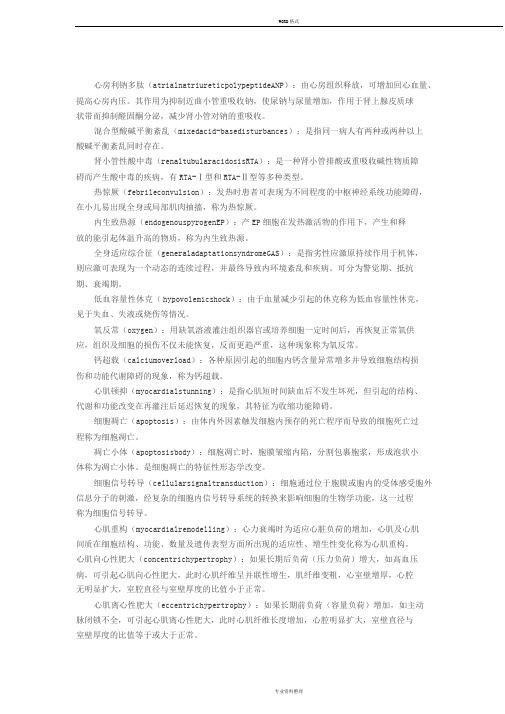
心房利钠多肽(atrialnatriureticpolypeptideANP):由心房组织释放,可增加回心血量、提高心房内压。
其作用为抑制近曲小管重吸收钠,使尿钠与尿量增加,作用于肾上腺皮质球状带而抑制醛固酮分泌,减少肾小管对钠的重吸收。
混合型酸碱平衡紊乱(mixedacid-basedisturbances):是指同一病人有两种或两种以上酸碱平衡紊乱同时存在。
肾小管性酸中毒(renaltubularacidosisRTA):是一种肾小管排酸或重吸收碱性物质障碍而产生酸中毒的疾病,有RTA-Ⅰ型和RTA-Ⅱ型等多种类型。
热惊厥(febrileconvulsion):发热时患者可表现为不同程度的中枢神经系统功能障碍,在小儿易出现全身或局部肌肉抽搐,称为热惊厥。
内生致热源(endogenouspyrogenEP):产EP细胞在发热激活物的作用下,产生和释放的能引起体温升高的物质,称为内生致热源。
全身适应综合征(generaladaptationsyndromeGAS):是指劣性应激原持续作用于机体,则应激可表现为一个动态的连续过程,并最终导致内环境紊乱和疾病。
可分为警觉期、抵抗期、衰竭期。
低血容量性休克(hypovolemicshock):由于血量减少引起的休克称为低血容量性休克,见于失血、失液或烧伤等情况。
氧反常(oxygen):用缺氧溶液灌注组织器官或培养细胞一定时间后,再恢复正常氧供应,组织及细胞的损伤不仅未能恢复,反而更趋严重,这种现象称为氧反常。
钙超载(calciumoverload):各种原因引起的细胞内钙含量异常增多并导致细胞结构损伤和功能代谢障碍的现象,称为钙超载。
心肌顿抑(myocardialstunning):是指心肌短时间缺血后不发生坏死,但引起的结构、代谢和功能改变在再灌注后延迟恢复的现象,其特征为收缩功能障碍。
细胞凋亡(apoptosis):由体内外因素触发细胞内预存的死亡程序而导致的细胞死亡过程称为细胞凋亡。
病理生理学名词解释

1.疾病(disease)是指机体在一定原因作用下,自稳调节机制发生紊乱而出现的异常生命活动过程。
2.病理生理学(pathophysiology)是一门侧重从功能和代谢角度,阐明疾病发生、发展和转归规律的学科。
3.药物靶标(drug target)是指任何药物进入人体后都是通过作用于特定组织细胞内的特定分子而生效的。
这种药物作用的特定分子称为药物靶标。
4.病理过程(pathologic process)是指不同器官、系统在许多不同疾病中可能出现的共同的、成套的功能代谢的变化。
5.病因(etiology agents)是指作用于机体引起疾病并赋予该疾病特征性的因素。
6.先天因素(congenital factors)并不是指遗传物质的改变,而是指那些对发育中的胚胎可能引起损害的因素。
其结果是致使胎儿出生时就已患病。
该类疾病称为先天性疾病。
7.疾病发生的条件(predisposing factors)是指在病因作用于机体的前提下,影响疾病发生发展的各种体内外因素。
8.诱发因素(precipitating factor)是指能够促进和加强某一疾病原因作用的条件因素称为诱发因素,简称诱因。
9.危险因素(dangerous factor)指某些可促进疾病发生的因素,但尚未阐明是否是该疾病的原因还是条件。
10.发病学(pathogenesis)主要研究病因如何作用于机体并导致疾病。
具体地,它主要涉及疾病发生的基本机制和疾病发生、发展、转归的普遍规律。
11.完全康复(complete recovery)是指病因去除后,患病机体的损伤和抗损伤反应完全消失、形态结构损伤完全修复、机体功能和代谢完全恢复到正常状态,以及临床症状和体征完全消退。
12.不完全康复(incomplete recovery)是指原始病因消除后,患病机体的损伤性变化得以控制,但机体内仍存在病理变化,只是机体通过代偿反应维持相对正常的生命活动。
病理生理学名词解释

1、健康(health):不仅是没有疾病或衰弱现象,而且是躯体上、精神上和社会适应上的一种完好状态。
2、疾病:是机体在一定病因作用下,机体内稳态调节紊乱而导致的异常生命活动过程。
3、亚健康(sub-health)状态:是介于健康与疾病之间的一种生理功能低下的状态。
此时机体处于非病、非健康并有可能趋向疾病的状态。
躯体性亚健康状态呈现“三多三低”:主诉症状多、自我感觉不适多、疲劳多,活力低、反应能力低、适应能力低,但机体无器质性病变证据。
4、老化(aging):是机体结构与功能随着年龄的增长而缓慢减退的不可逆过程,是所有生物的共同特征。
(“生理性”)5、衰老(senescence):是机体在增龄过程中由于形态改变、功能减退、代谢失调而导致内环境紊乱和对外部环境适应能力下降的综合状态。
(“病理性”)6、病因:疾病发生的原因,又称致病因素。
指能引起某一疾病的特定因素,决定该病的特异性,是引起疾病的必不可少的因素。
包括生物因素、理化因素、遗传因素、环境生态因素、先天因素、营养因素、免疫因素、心理和社会因素。
7、条件:主要指能促进或减缓疾病发生的某种机体状态或自然环境。
8、脑死亡:脑死亡是指全脑功能(包括大脑、间脑和脑干)不可逆性的永久性丧失以及机体作为一个整体功能的永久性停止。
(脑死亡的标准:自主呼吸停止,人工呼吸15分钟仍无自主呼吸;不可逆性深昏迷;颅神经反射(瞳孔反射、角膜反射、咳嗽反射、吞咽反射等)均消失;瞳孔散大及固定;脑电波消失;脑血液循环完全停止。
)9、低渗性脱水:(低容量性低钠血症)体液容量减少,失Na+>失水,血清Na+浓度<130 mmol/L,血浆渗透压<280 mOsm/L。
10、等渗性脱水:体液容量减少,水与Na+成比例丢失,血清Na+浓度和血浆渗透压仍在正常范围内。
11、高渗性脱水:(低容量性高钠血症)体液容量减少,失水>失钠,血清Na+浓度> 150 mmol/L,血浆渗透压>310 mOsm/L。
病理生理学 名词解释

1、病理过程:(fundamental pathological process)多种疾病中出现的、共同的、成套的功能、代谢和结构的病理生理变化。
2、健康:(health)健康不仅仅是没有疾病,而且是身体上、精神和社会上的完全良好状态。
3、疾病:(disease)在病因的损伤和机体的抗损伤作用下,因自稳调节紊乱而发生的异常生命活动过程。
4、疾病发生的原因:(etiological factors)能够引起某一疾病并决定疾病特异性的因素。
5、条件:(precipitating factors)病因作用于机体前提下,影响疾病发展的因素。
6、死亡:(death)机体作为一个整体功能的丧失。
7、水肿:concept 过多的液体积聚在组织间隙或体腔的病理过程,称为水肿。
8、低钾血症:(hypokalemia血浆中钾离子浓度小于3.5mmol/L的病理过程。
9、高钾血症:(hyperkalemia)血浆中钾离子浓度大于5.5mmol/L的病理过程。
10、脱水:(dehydration)体液容量减少(>2%)并引起一系列功能代谢变化的现象。
11、低渗性脱水(hypovolemic dehydration):失钠多于失水,血清中钠离子浓度小于130mmol/L,血浆渗透压小于280 mmol/L,伴有细胞外液量的减少。
12、高渗性脱水(hypertonic dehydration):失水多于失钠,血清中钠离子浓度大于150mmol/L,血浆渗透压大于330 mmol/L,细胞外液量和细胞内液量均减少。
13、代谢性酸中毒(metabolic acidosis):ECF中H增加和(或)HCO3- 丢失而引起的以血浆HCO3-减少、pH呈降低趋势为特征的ABD。
14、呼吸性酸中毒(respiratory acidosis):二氧化碳排出障碍或吸入过多引起的以血浆碳酸浓度升高,pH呈降低趋势为特征的ABD。
15、代谢性碱中毒(metabolic alkalosis):ECF中碱增多或H丢失而引起的以血浆HCO3-增多、pH呈上升趋势为特征的ABD。
病理生理学病名词解释

1.疾病(disease)是指机体在一定原因作用下,自稳调节机制发生紊乱而出现的异常生命活动过程。
2.病理生理学(pathophysiology)是一门侧重从功能和代谢角度,阐明疾病发生、发展和转归规律的学科。
3.药物靶标(drug target)是指任何药物进入人体后都是通过作用于特定组织细胞内的特定分子而生效的。
这种药物作用的特定分子称为药物靶标。
4.病理过程(pathologic process)是指不同器官、系统在许多不同疾病中可能出现的共同的、成套的功能代谢的变化。
5.病因(etiology agents)是指作用于机体引起疾病并赋予该疾病特征性的因素。
6.先天因素(congenital factors)并不是指遗传物质的改变,而是指那些对发育中的胚胎可能引起损害的因素。
其结果是致使胎儿出生时就已患病。
该类疾病称为先天性疾病。
7.疾病发生的条件(predisposing factors)是指在病因作用于机体的前提下,影响疾病发生发展的各种体内外因素。
8.诱发因素(precipitating factor)是指能够促进和加强某一疾病原因作用的条件因素称为诱发因素,简称诱因。
9.危险因素(dangerous factor)指某些可促进疾病发生的因素,但尚未阐明是否是该疾病的原因还是条件。
10.发病学(pathogenesis)主要研究病因如何作用于机体并导致疾病。
具体地,它主要涉及疾病发生的基本机制和疾病发生、发展、转归的普遍规律。
11.完全康复(complete recovery)是指病因去除后,患病机体的损伤和抗损伤反应完全消失、形态结构损伤完全修复、机体功能和代谢完全恢复到正常状态,以及临床症状和体征完全消退。
12.不完全康复(incomplete recovery)是指原始病因消除后,患病机体的损伤性变化得以控制,但机体内仍存在病理变化,只是机体通过代偿反应维持相对正常的生命活动。
病理生理学病名词解释
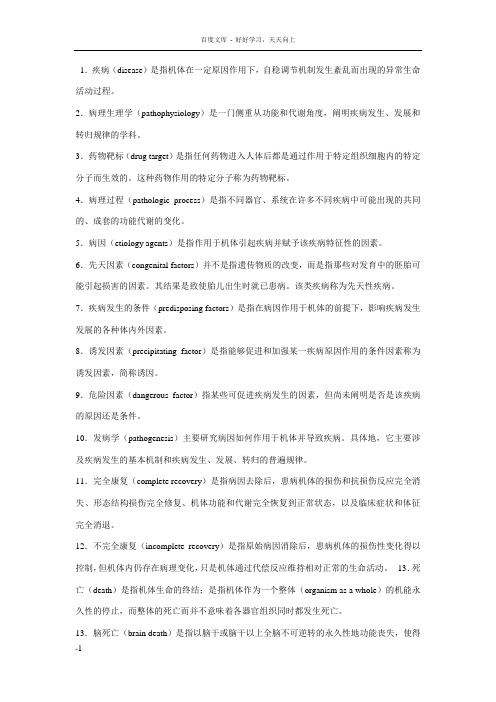
1.疾病(disease)是指机体在一定原因作用下,自稳调节机制发生紊乱而出现的异常生命活动过程。
2.病理生理学(pathophysiology)是一门侧重从功能和代谢角度,阐明疾病发生、发展和转归规律的学科。
3.药物靶标(drug target)是指任何药物进入人体后都是通过作用于特定组织细胞内的特定分子而生效的。
这种药物作用的特定分子称为药物靶标。
4.病理过程(pathologic process)是指不同器官、系统在许多不同疾病中可能出现的共同的、成套的功能代谢的变化。
5.病因(etiology agents)是指作用于机体引起疾病并赋予该疾病特征性的因素。
6.先天因素(congenital factors)并不是指遗传物质的改变,而是指那些对发育中的胚胎可能引起损害的因素。
其结果是致使胎儿出生时就已患病。
该类疾病称为先天性疾病。
7.疾病发生的条件(predisposing factors)是指在病因作用于机体的前提下,影响疾病发生发展的各种体内外因素。
8.诱发因素(precipitating factor)是指能够促进和加强某一疾病原因作用的条件因素称为诱发因素,简称诱因。
9.危险因素(dangerous factor)指某些可促进疾病发生的因素,但尚未阐明是否是该疾病的原因还是条件。
10.发病学(pathogenesis)主要研究病因如何作用于机体并导致疾病。
具体地,它主要涉及疾病发生的基本机制和疾病发生、发展、转归的普遍规律。
11.完全康复(complete recovery)是指病因去除后,患病机体的损伤和抗损伤反应完全消失、形态结构损伤完全修复、机体功能和代谢完全恢复到正常状态,以及临床症状和体征完全消退。
12.不完全康复(incomplete recovery)是指原始病因消除后,患病机体的损伤性变化得以控制,但机体内仍存在病理变化,只是机体通过代偿反应维持相对正常的生命活动。
- 1、下载文档前请自行甄别文档内容的完整性,平台不提供额外的编辑、内容补充、找答案等附加服务。
- 2、"仅部分预览"的文档,不可在线预览部分如存在完整性等问题,可反馈申请退款(可完整预览的文档不适用该条件!)。
- 3、如文档侵犯您的权益,请联系客服反馈,我们会尽快为您处理(人工客服工作时间:9:00-18:30)。
1.DiseaseDisease is referred as an aberrant manifestation of homeostatic disturbances caused by harmful agents.2.Causative factor / pathogenic causeCausative factor or pathogenic cause is referred as the factor that can cause a disease and determine its specificity.3.HypoxiaHypoxia can be defined as a deficiency in either oxygen delivery or its utilization at the tissue level or the deficiency of both, which can lead to changes in function, metabolism and even structure of the body.4.CyanosisCyanosis refers to the violaceous color of skin and mucous membranes which occurs as the deoxyhemoglobin concentration of the blood in capillaries becomes greater than 5g/dl.5.Hemic hypoxiaHemic hypoxia refers to hypoxia resulting from a low carrying capacity of oxygen in the blood caused by an altered affinity of Hb for oxygen or a decrease in the amount of Hb in the blood.6.Enterogenous cyanosisWhen pickled vegetables containing nitrate are consumed in large amounts, the reabsorbed nitrate reacts with HbFe2+ to form HbFe3+OH. The color of skin becomes coffee color. This phenomenon is called enterogenous cyanosis.7.Ischemic hypoxiaThe deficiency of blood perfusion to tissues caused by decreased arterial pressure or obstruction of arteries is called ischemic hypoxia.8.FeverFever is a complicated pathological process characterized by a regulated elevation of core body temperature, in which the hypothalamic set point is temporarily reset at an elevated temperature in response to pyretic substances.9.Pyrogenic activatorsFever can be caused by a number of microorganisms and non-microbial pyretic substances, which are collectively called pyrogenic activators.10.Endogenous pyrogensEndogenous pyrogens are described as cytokines inducing fever, which are produced and released by EP cells, such as interleukin-1, tumor necrosis factor, etc.11.StressIt is defined as a systemic nonspecific response of the body to environmental demands or pressures made upon it.12.StressorThe stimulus that provokes a stress response is referred to as stressor.13.ShockShock is a pathological process caused by various drastic etiological factors, which is characterized by microcirculation failure resulting from decreased effective circulatory blood volume and inadequate tissue perfusion with the results of cellular metabolism impediment and dysfunction of multiple vital organ.14.Auto blood transfusionAt the early stage of shock, vessel constriction because of release of a large amount of vasoconstrictors may mobilize the stored blood to participate in the circulation, which is considered as compensation of venous return. 15.Auto fluid transfusionAt the early stage of shock, significant decrease of hydrostatic pressure in capillary may drive fluid to shift from interstitial space to the vascular compartment, and as a result, the plasma volume can be partly restored as a compensatory response16.Disseminated intravascular coagulation (DIC)DIC is a pathological process caused by disturbance of the kinetic balance between coagulation and anticoagulation systems (including fibrinolytic system). Etiologic factors activate extensive intravascular coagulation and secondary fibrinolysis. The clinical features of DIC are bleeding, shock, organ dysfunction and microangiopathic hemolytic anemia.17.Heart failureHeart failure is a pathological process in which the systolic or/ and diastolic function of the heart is impaired, and as a result, cardiac output decreases and is unable to meet the metabolic demands of the body.18.High-output failureHigh-output failure indicates that the cardiac output may be supra- normal but inadequate owing to excessive metabolic needs. The causes of high-output heart failure include severe anemia, fever, hyperthyroidism and pregnancy, etc.19.Ischemia- reperfusion injuryThe restoration of blood flow after transient ischemia may be associated with further reversible or irreversible cell damage, which is called ischemia-reperfusion injury or reperfusion injury.20.Calcium overloadCalcium overload refers to that intracellular content of calcium is increased abnormally during ischemia and reperfusion, which results in the disorder of cellular structure and function.21.Systemic inflammatory response syndrome (SIRS)Systemic inflammatory response syndrome is a hard-controlling systemic inflammatory cascade caused by severe infectious or non-infectious factors. It leads to disorders of microcirculatory perfusion of organs and finally to secondary organ dysfunction.22.Multiple organ dysfunction syndrome (MODS)Multiple organ dysfunction syndrome is defined as a progressive dysfunction of two or more organs or systems resulting from an uncontrolled systemic inflammatory response to a severe illness or injury.23.Anion gap (AG)It is the deference between the concentrations of unmeasured anion (UA) and unmeasured cation (UC) in plasma (AG=UA-UC). The AG value can be obtained by calculating the difference between plasma concentrationof major measured cation (Na +) and the sum of the plasma concentrations of major measured anions (Cl - andHCO 3-), that is, AG = [Na +] - ([Cl -] + [HCO 3-]). Its normal range is 12±2 mmol/L.24.EdemaEdema means that excessive fluid accumulates in interstitial compartment and some cavities in the body.25.Brain deathBrain death is a state of permanent irreversible cessation of whole brain activity. At that time, the function of the patient's body as a whole body has stopped forever.。
